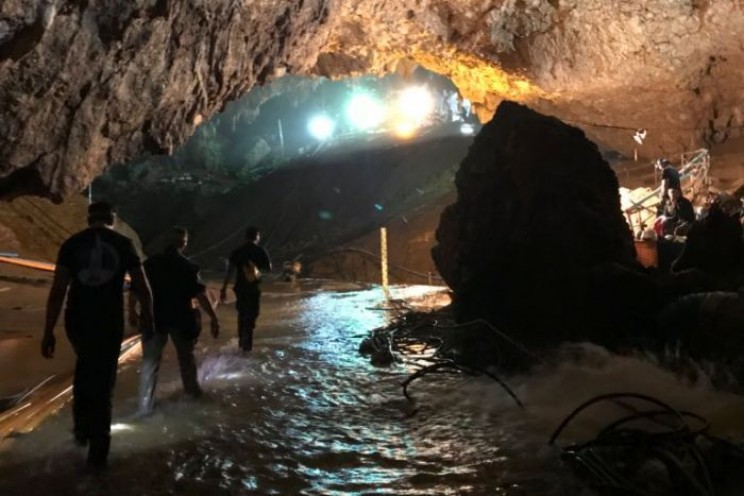THAILAND COVERNMENT RESCUE BOYS FROM DEATH CAVE;

The Thai give in complex where 12 young men and their football mentor ended up caught is a winding arrangement of sinkholes and fissure which represented a scope of issues for rescuers
A few stretches of the Tham Luang surrender are more than 10m (33ft) high, while others are a tight press through water-filled entries.


The passing of an accomplished previous Thai naval force jumper, who was a piece of a group attempting to supply the young men’s give in with oxygen tanks, stressed the threats of the mission.
The gathering of young men and their mentor were investigating the caverns when a sudden tempest caused the paths to surge, catching them inside. They had burned through nine days in the give in with little nourishment or light when they were found on Monday 2 July.
Rescuers at first needed to keep the gathering provided underground until the finish of the stormy season – which would have taken months.
Be that as it may, with the figure of substantial downpours, and the danger of water levels rising, an activity was propelled on Sunday, 8 July, to bring them out.


How did the young men escape?
Save jumpers with pro breathing hardware achieved the gathering through a progression of water-filled sections.
The young men must be drawn out a similar way.
Sources in the save activity, including jumpers who participated, told the BBC that the young men were intensely quieted in front of the protect to anticipate them freezing oblivious, tight, submerged ways.
The young men were fitted with full-confront breathing covers. For the submerged segments, they were tied to a safeguard jumper, with another jumper following behind. The jumpers were guided through the dull by plunge lines. In limited areas, rescuers needed to remove their air tanks and press the young men and the tanks through.
English rescuer John Volanthen, one of the individuals who initially found the young men, said jumpers could hone safeguard methods with Thai young men from a nearby swimming club in a pool.
“We tied a chamber to the front of the youngster and they had a full-confront veil… and basically we had an idea about the back of the kid,” he said
The jumpers were then ready to move the young men look down along the ways.
“In the event that you need a photo, it was most likely more like a shopping pack that occasionally you would hold away from plain view if the section was limited and profound. On the off chance that the entry was low and wide you would hold them out to the side and basically move them around any hindrances that were standing out,” he said.
The young men were cut to the jumpers for wellbeing on the off chance that they dismissed them in the dim water.
The plunging choice was considered amazingly unsafe by a few, yet jump specialists said the need was to get the young men out before the downpours brought all the more flooding and garbage into the surrender framework.
Around 40% of the young men’s excursion through the water included jumping and in different parts the water was up to the rescuers’ chests, Thai Navy SEAL authority Rear Admiral Apakorn Yuukongkaew told journalists.
After the overwhelmed segment, when they achieved the jumpers’ working base the give in, the young men were packaged into stretchers and conveyed or winched along ropes, as indicated by film discharged by the Thai Navy Seals.



Each voyage back to the passage took a few hours.
The safeguard mission began on 8 July, with jumpers entering the give in at 10:00 neighborhood time (03:00 GMT). The primary kid developed at 17:40 and by 19:47, three more had taken after.
The mission was delayed medium-term for air tanks to be supplanted along the course yet continued again on Monday and Tuesday until the rest of the young men and their mentor were conveyed out and exchanged to healing center.
Pausing and pumping
There was a round-the-clock drawing activity to attempt to clear the hollows.
However, as quick as the water was being directed out, more was streaming in, encouraged by sinkholes and streams in the slopes above, and the dangers from the up and coming storm downpours was high.
Mr Narongsak said the mission had been “a race against the water”
Boring down
The specialists tried to penetrate openings in the give in dividers to help deplete a portion of the surge water – despite the fact that the thick shake hampered endeavors.
There were likewise proposals that boring could be another approach to get to the young men and lift them out.
Yet, to try and start the procedure, new streets would have been should have been developed over the caverns to oblige the substantial boring gear expected to get through the stone.
What were the threats down there?
The young men, matured in the vicinity of 11 and 17, and their 25-year-old mentor had been crouched on a little shake edge. The earth was wet, so they needed to keep warm and dry or hazard hypothermia.
There were worries about the level of oxygen noticeable all around in the space where the young men were caught. Authorities said at one point that the level of oxygen noticeable all around had tumbled to 15%. The typical level is 21%.
Rescuers exchanged around 100 oxygen tanks to the surrender to help enhance the air supply.
Thai jumper PO Saman had been helping exchange the tanks when he got into challenges in transit back and did not have enough air himself. He kicked the bucket subsequent to losing awareness in one of the paths and his associates couldn’t resuscitate him
They’re rationally steady which is in reality entirely great,” Ben Reymenants, a Belgian jumper assisting with the safeguard activity, disclosed to AFP news organization.

